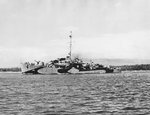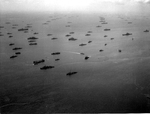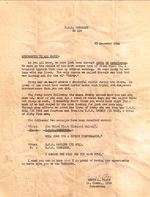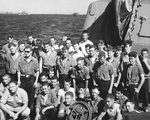Tabberer
| Country | United States |
| Ship Class | John C. Butler-class Destroyer Escort |
| Hull Number | DE-418 |
| Builder | Brown Shipbuilding Company, Houston, Texas, United States |
| Laid Down | 12 Jan 1944 |
| Launched | 18 Feb 1944 |
| Commissioned | 23 May 1944 |
| Decommissioned | 24 Apr 1946 |
| Displacement | 1,745 tons standard |
| Length | 306 feet |
| Beam | 37 feet |
| Draft | 13 feet |
| Machinery | 2 Geared steam turbines, 2 screws |
| Power Output | 12,000 shaft horsepower |
| Speed | 24 knots |
| Crew | 215 |
| Armament | 2x5in/38cal guns, 1x3x21in torpedo tubes, 2x2x40mm anti-aircraft guns, 10x20mm anti-aircraft guns, 1x Hedgehog anti-submarine mortar, 8x depth charge launchers, 2x depth charge racks |
| Recommission | 7 Apr 1951 |
| Final Decommission | May 1960 |
Contributor: David Stubblebine
ww2dbaseThe USS Tabberer was a John C. Butler-class destroyer escort. Destroyer escorts were theoretically less of a warship than destroyers but in fact the John C. Butler-class were larger and better armed than the Mahan-class destroyers, although with a reduced top speed. Colloquially known as the "Tabby," Tabberer was named for Lieutenant (jg) Charles Tabberer, a naval aviator and Distinguished Flying Cross recipient who was killed 7 Aug 1942 over Tulagi in the Solomon Islands while flying from the carrier USS Saratoga in support of operations on Guadalcanal.
ww2dbaseThe Tabberer was laid down on 12 Jan 1944 at the Brown Shipbuilding Company in Houston, Texas, United States. The ship was launched 18 Feb 1944 and sponsored by the widow of Lieutenant (jg) Tabberer, Mrs. Mary M. Tabberer. USS Tabberer was commissioned 23 May 1944 with Lieutenant Commander Henry L. Plage in command.
ww2dbaseBefore Tabberer ever left Texas, there were already signs that the ship would be expected to perform rugged duty. On 29 May 1944 while shifting berths in Galveston with a Coast Guard pilot at the conn, Tabberer rammed the side of a floating drydock that caused minor damage to Tabberer's stem and capsized a motor whaleboat alongside.
ww2dbaseTabberer entered the Gulf of Mexico for the first time on 3 Jun 1944 for full-speed trials and departed on her shakedown cruise to Bermuda 28 Jun 1944. She then arrived at Boston Naval Yard on 4 Aug 1944 for a post-shakedown refit.
ww2dbaseTabberer sailed from Boston 16 Aug 1944 for Norfolk, Virginia where she joined fleet oiler USS Severn as an escort. The two ships transited the Panama Canal 25 Aug 1944 and arrived at Pearl Harbor, Hawaii 7 Sep 1944. Then for over a month, Tabberer trained in Hawaiian waters including anti-submarine tactics and gunnery drills. She also screened and served as plane guard for escort carrier USS Coral Sea and fleet carriers USS Saratoga and USS Ranger during night flying qualifications and amphibious support training.
ww2dbaseOn 16 Oct 1944, Tabberer departed Pearl Harbor as part of a submarine hunter-killer group centered around the escort carrier USS Anzio (formerly the USS Coral Sea). The group headed west where they became a part of Admiral William Halsey's Third Fleet. On 18 Nov 1944, the Anzio group made its first successful submarine attack east of the Philippines with a coordinated air/sea attack on Japanese submarine I-41 commanded by Lieutenant Commander Kondo Fumitake. I-41 was lost with all hands.
ww2dbaseFollowing a brief replenishment period at Ulithi, Tabberer and her group resumed anti-submarine sweeps in the Philippine Sea in advance of Vice-Admiral John McCain's Fast Carrier Task Force 38. Ever alert for submarines, enemy ships, and air attacks, Tabberer was about to be threatened by a most unexpected enemy.
ww2dbaseOn 16 Dec 1944, McCain's carriers withdrew from the Philippines for refueling and Anzio's anti-submarine group followed. After a morning rendezvous with the replenishment group 180 miles northeast of the Philippine island of Samar, the ships experienced increasing winds and rough seas that forced an early end to the fueling operations. The barometers dropped quickly, the weather grew worse, and soon the fleet was fighting hurricane force winds. The ships had unexpectedly sailed directly into the powerful tropical Typhoon Cobra.
ww2dbaseBy mid-day, the waves had increased to the point Tabberer could not fight her way out of the deep troughs. She took on rolls of 60 degrees and sometimes more. Captain Plage ordered anything that was not permanently affixed to the ship to be repositioned to the lower spaces to improve stability. Winds increased to an estimated 100 knots or more and visibility became very poor. The continuous heavy rolling caused the wire supports for Tabberer's main mast to begin giving way. The mast swayed more and more violently throughout the afternoon and during one 50-degree roll just as darkness was falling, the mast buckled altogether. All radar and radio antennas were lost as the mast hung over the side of the ship. After 30 minutes of torch and axe work in the heavy seas, the mast was cut away and the ship's handling improved immediately. Water entering through air vents had caused some short-circuiting in the switchboards and generators below decks but the vents and the equipment were covered and no more electrical trouble was experienced. At no time did Tabberer lose power.
ww2dbaseBy late evening, conditions had improved enough to allow Chief Radiomans Mate Ralph Tucker to begin rigging an emergency radio antenna on Tabberer's stack. While conducting this work in the dark, he noticed an occasional light shining from the waves close aboard. He called out into the darkness and thought he heard a voice call back from the sea. Tucker quickly sounded the "Man Overboard" alarm. Captain Plage immediately altered course and reduced speed. After some tricky seamanship and no small amount of stark bravery from the crew, Quartermaster 3rd-class August Lindquist was pulled from the sea. He said he was a crew member from the destroyer USS Hull that had foundered and sunk in the typhoon about mid-day. His lifejacket had been equipped with a single-cell flashlight and a whistle, as had many of the Hull's lifejackets, and the flashlight is what allowed Chief Tucker to see him in the darkness.
ww2dbaseThus, Tabberer was the first ship to become aware that another ship had gone down in the storm; but until the makeshift antenna could be rigged, Plage had no way of relaying that information to the fleet. In the meantime, he set extra watches to look for more lights in the water and listen for whistles. Soon, more Hull sailors were spotted in the water. Rescue work continued through the night, throughout the following day, and into the day after that. Once communications had been restored, Tabberer was ordered to return to the fleet so her damage could be assessed and other ships would complete the rescue work. But Plage knew those other ships were not yet on the scene and Tabberer was, so Plage disobeyed orders and continued searching for men in the water. By the time Plage was physically relieved by other search ships, Tabberer had recovered 55 officers and men, 41 from Hull and 14 from the similarly sunken USS Spence. The ships that took over the search rescued another 36 men from Hull, Spence, and also USS Monaghan. At the conclusion of Tabberer's search for survivors on 20 Dec 1944, Captain Plage issued a captain's memorandum of commendation to his crew recognizing their hard work and courage.
ww2dbaseFive days after being first consumed by the typhoon, Tabberer entered the fleet anchorage at Ulithi for repairs. While at Ulithi, Admiral Halsey came aboard with a box full of medals. For their courageous rescue work during the storm, Tabberer's executive officer Lieutenant Robert Surdam, the gunnery officer Lieutenant Howard Korth, Boatswains Mate 1st-class Louis Purvis, and Torpedomans Mate 1st-class Robert Cotton were all awarded Navy and Marine Corps medals, awards customarily given for non-combat lifesaving work. For his courageous leadership and skilled seamanship, Lieutenant Commander Plage received the Legion of Merit, one of the highest non-combat awards. The ship and the entire ship's company were among the first to receive the newly created Navy Unit Commendation. According to Tabberer's war history, Halsey's remarks to the crew that day included:
ww2dbase"Your seamanship, endurance, and courage, and the plain guts that you exhibited during the typhoon that we went through is an epic of naval history and will long be remembered by your children and their children's children.
ww2dbase"It is this spirit displayed throughout the world by the American forces of all branches that is winning the war for us."
ww2dbaseTabberer departed Ulithi on 30 Dec 1944 bound for Pearl Harbor via Eniwetok. Tabberer sailed in company with light carrier USS Monterey and destroyer escorts USS Conklin and USS Melvin R. Nawman - all four ships having received significant damage in the typhoon. Conklin detached at Eniwetok and Tabberer and the remaining ships arrived at Pearl Harbor on 10 Jan 1945. After 19 days of repairs and yard availability, Tabberer with her new mast sailed for Eniwetok as an escort for a small convoy. Ironically, one of the merchant ships in that convoy was the SS Typhoon.
ww2dbaseTabberer arrived at Eniwetok on 6 Feb 1945 and immediately rejoined carrier USS Anzio as part of her anti-submarine task group. The group swept the track of a convoy leaving Eniwetok bound for Saipan and then, without stopping, Tabberer screened a group of five escort carriers from Saipan to Iwo Jima where the carriers launched pre-invasion bombing raids against the island. Tabberer remained around Iwo Jima for four weeks screening the carriers, sometimes joining Anzio in night anti-submarine sweeps, and occasionally repelling air attacks. On 7 Mar 1945, Tabberer and the Anzio group departed the Iwo Jima area and sailed for Leyte in the Philippines.
ww2dbaseAfter replenishment, Tabberer sailed for Okinawa on 21 Mar 1945 as part of the screen for three escort carriers. Once around Okinawa, these carriers merged with four other escort carriers and Tabberer merged with their screening group as the carriers launched strikes against Okinawa. Tabberer and Anzio's hunter-killer group continued their occasional nighttime anti-submarine sweeps. Except for occasional brief stops at Kerama Rhetto for rearming, Tabberer remained on station around Okinawa for 52 days until 12 May 1945 when she put into Apra Harbor, Guam for ten days.
ww2dbaseTabberer then returned to Anzio's anti-submarine group and spent 36 days sweeping the supply routes leading to Okinawa until 17 Jun 1945 when the group steamed for Leyte. While at Leyte on 5 Jul 1945, in a normal rotation of command, Lieutenant Commander Dean DeCoudres relieved Lieutenant Commander Henry Plage as Tabberer's commanding officer. The next day, Tabberer sailed with the Anzio group again and they resumed their patrols of the shipping lanes to Okinawa. On 12 Jul 1945, Tabberer had the chance to pluck another friendly sailor from the water. This time, Ensign Robert Casey's FM-2 Wildcat lost power upon takeoff from Anzio and had to make a water landing. Tabberer picked up the pilot and returned him to Anzio later that day. Forty-one days after leaving Leyte, Tabberer was still screening Anzio's anti-submarine group when Japan surrendered on 15 Aug 1945.
ww2dbaseTabberer remained in the Far East to support the occupation forces including escorting other ships and destroying floating mines. On 22 Dec 1945, Tabberer departed Tsingtao, China (now Qingdao) bound for the United States. She entered San Francisco Bay on 15 Jan 1946 and, after shifting to San Diego, was placed out of commission and put in reserve on 24 Apr 1946.
ww2dbaseDuring the Navy's build-up for the Korean War, Tabberer was recommissioned at San Diego on 7 Apr 1951 with Lieutenant Commander Willard McNulty in command. She reported for duty with the Atlantic Fleet and for the next nine years, Tabberer operated along the Atlantic seaboard from Halifax, Nova Scotia to Key West, Florida and into the Caribbean. Tabberer participated in a variety of exercises and on several occasions embarked United States Naval Academy and Naval ROTC midshipmen for their summer cruises.
ww2dbaseOn 19 Apr 1959, Tabberer put into port for the last time. At the Philadelphia Navy Yard, she began preparations for deactivation. Placed out of commission in May 1960, she laid up with the Philadelphia Reserve Fleet until 1 Jul 1972 when she was stricken from the Naval Vessel Register. On 3 Oct 1973, the ex-"Tabby" was sold for scrap.
ww2dbaseIn just 15 months of World War II service, Tabberer was awarded four battle stars, received one Navy Unit Commendation, and survived one brutal typhoon.
ww2dbaseSources:
United States Navy
History Channel - Wrath of God: Halsey's Typhoons - Peril on the Sea (2000)
Bob Drury & Tom Clavin: Halsey's Typhoon - Grove Press, 2007
FindAGrave
USS Hull Association
CombinedFleet Imperial Japanese Navy History
NavSource Naval History
Wikipedia
Last Major Revision: May 2021
Destroyer Escort Tabberer (DE-418) Mapa Interativo
Photographs
 |  |  |  |
Tabberer Operational Timeline
| 7 ago 1942 | Aircraft from USS Saratoga flew several strikes against targets on Guadalcanal and in support of landings on Tulagi in the Solomon Islands. Pilot Lt(jg) Charles Tabberer was one of five out of eight pilots to go missing over Tulagi. |
| 12 jan 1944 | John C. Butler-class destroyer escort Tabberer was laid down at Brown Shipbuilding Company, Houston, Texas, United States. |
| 18 fev 1944 | Destroyer escort Tabberer was launched at Brown Shipbuilding Company, Houston, Texas, United States sponsored by the widow of Lt(jg) Charles Tabberer, Mrs. Mary M. Tabberer. |
| 23 mai 1944 | Destroyer escort USS Tabberer was commissioned at Houston, Texas, United States with LtCdr Henry Plage in command. |
| 29 mai 1944 | While shifting berths under the control of a Coast Guard harbor pilot, destroyer escort USS Tabberer rammed a floating drydock in Galveston Bay, Texas, United States. |
| 4 jul 1944 | Destroyer escort USS Tabberer arrived at Great Sound, Bermuda on her shakedown cruise. |
| 4 ago 1944 | Destroyer escort USS Tabberer arrived at the Boston Navy Yard for a post-shakedown refit. |
| 18 ago 1944 | Fleet oiler USS Severn with destroyer escort USS Tabberer departed Norfolk, Virginia, United States bound for the Panama Canal. |
| 25 ago 1944 | Fleet oiler USS Severn with destroyer escort USS Tabberer transited the Panama Canal into the Pacific. |
| 7 set 1944 | Fleet oiler USS Severn with destroyer escort USS Tabberer arrived at Pearl Harbor, Hawaii. |
| 18 nov 1944 | Ships and aircraft from the hunter-killer group built around escort carrier USS Anzio conducted a coordinated attack 350 miles east of the Philippines on the submerged Japanese submarine I-41 commanded by LtCdr Kondo Fumitake. Destroyer escort USS Lawrence C. Taylor launched a successful spread of Hedgehog anti-submarine mortars and the I-41 was lost with all hands. Other ships in the Anzio group were USS Melvin R. Nawman, USS Tabberer, USS Oliver Mitchell, and USS Robert F. Keller. |
| 18 dez 1944 | Muitos navios da Terceira Frota dos Estados Unidos, Força-Tarefa 38, navegaram para o Tufão Cobra no Mar das Filipinas. Três destroyers e 790 homens foram perdidos. |
| 20 dez 1944 | Após três dias e duas noites de busca por sobreviventes na água após o Tufão Cobra, o contratorpedeiro de escolta USS Tabberer foi dispensado da busca por outros navios após recuperar 55 homens da água. |
| 29 dez 1944 | Admiral William Halsey came aboard destroyer escort USS Tabberer at Ullithi and presented awards to the commanding officer, LtCdr Henry Plage, as well as several crewmembers for their performance in rescuing 55 sailors from ships sunk during Typhoon Cobra. USS Tabberer and all hands were also awarded the Navy Unit Commendation for these same efforts. |
| 13 fev 1945 | Destroyer escort USS Tabberer arrived off Saipan, Mariana Islands and delivered a supply convoy. Tabberer then sailed with escort carrier USS Anzio and destroyer USS Ralph Talbot for Iwo Jima. |
| 16 fev 1945 | USS Anzio, USS Tabberer, and the rest of their task group arrived southwest of Iwo Jima where the carriers launched pre-invasion strikes against the island. |
| 12 mar 1945 | USS Steamer Bay, USS Anzio, and USS Tabberer arrived at San Pedro Bay, Leyte, Philippines. |
| 27 mar 1945 | USS Anzio and USS Tabberer arrived on station off Okinawa and remained for 52 days covering the landings there. |
| 25 jul 1945 | In a normal rotation of command, Lieutenant Commander Dean DeCoudres relieved Lieutenant Commander Henry Plage as USS Tabberer's commanding officer at San Pedro Bay, Leyte Gulf, Philippines. |
| 22 dez 1945 | O contratorpedeiro de escolta USS Tabberer partiu de Tsingtao, China (agora Qingdao) com destino aos Estados Unidos. |
| 1 mar 1946 | Lieutenant Commander Bruce Kroger was made the commanding officer of USS Tabberer, relieving Dean Decoudres. |
| 24 abr 1946 | Destroyer escort USS Tabberer was placed out of commission at San Diego, California and placed in the reserve fleet. |
| 7 abr 1951 | Destroyer escort USS Tabberer was placed back in commission at San Diego, California. |
| 1 mai 1960 | [appx date] Destroyer escort USS Tabberer was placed out of commission for the last time at Philadelphia, Pennsylvania and was later scrapped. |
| 1 jul 1972 | Tabberer was struck from the US Naval Register. |
Você gostou deste artigo ou achou este artigo útil? Se sim, considere nos apoiar no Patreon. Qualquer valor já vai ajudar! Obrigado. Por favor, ajude-nos a divulgar o site: Fique atualizado com WW2DB: |

» Plage, Henry
Event(s) Participated:
» Philippines Campaign, Phase 1, the Leyte Campaign
» Typhoon Cobra
» Battle of Iwo Jima
» Okinawa Campaign
 |
- » 1,180 biografias
- » 337 eventos
- » 45,098 entradas na linha do tempo
- » 1,246 navios
- » 350 modelos de aeronaves
- » 207 modelos de veículos
- » 376 modelos de armas
- » 123 documentos históricos
- » 261 instalações
- » 470 eventos
- » 28,467 fotos
- » 365 mapas
Thomas Dodd, late 1945
Por favor, considere nos apoiar no Patreon. Mesmo R$1 por mês já faz uma grande diferença. Obrigado!
Ou, por favor, nos apoie adquirindo alguns produtos do WW2DB na TeeSpring. Obrigado!